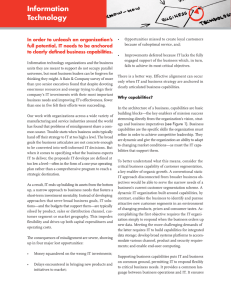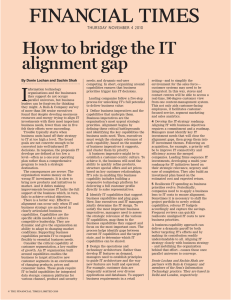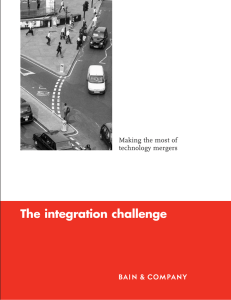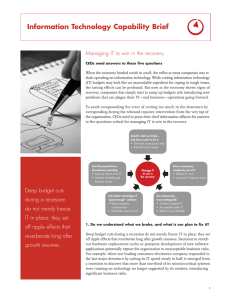Information Technology
advertisement
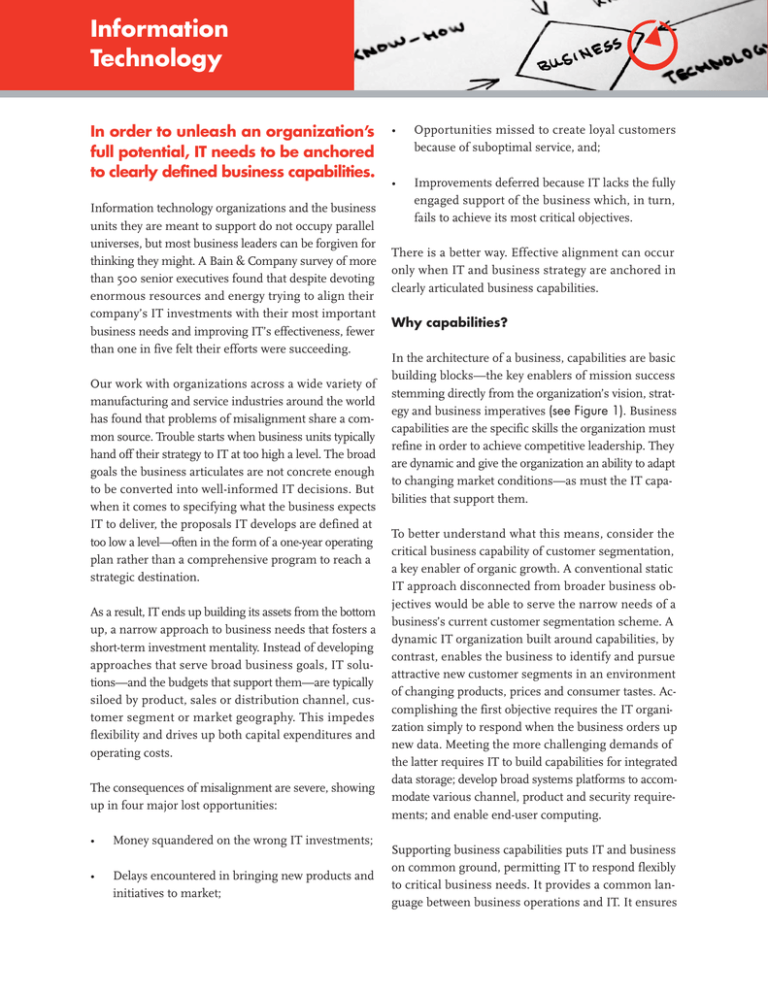
Information Technology In order to unleash an organization’s full potential, IT needs to be anchored to clearly defined business capabilities. Information technology organizations and the business units they are meant to support do not occupy parallel universes, but most business leaders can be forgiven for thinking they might. A Bain & Company survey of more than 500 senior executives found that despite devoting enormous resources and energy trying to align their company’s IT investments with their most important business needs and improving IT’s effectiveness, fewer than one in five felt their efforts were succeeding. Our work with organizations across a wide variety of manufacturing and service industries around the world has found that problems of misalignment share a common source. Trouble starts when business units typically hand off their strategy to IT at too high a level. The broad goals the business articulates are not concrete enough to be converted into well-informed IT decisions. But when it comes to specifying what the business expects IT to deliver, the proposals IT develops are defined at too low a level—often in the form of a one-year operating plan rather than a comprehensive program to reach a strategic destination. As a result, IT ends up building its assets from the bottom up, a narrow approach to business needs that fosters a short-term investment mentality. Instead of developing approaches that serve broad business goals, IT solutions—and the budgets that support them—are typically siloed by product, sales or distribution channel, customer segment or market geography. This impedes flexibility and drives up both capital expenditures and operating costs. The consequences of misalignment are severe, showing up in four major lost opportunities: • Money squandered on the wrong IT investments; • Delays encountered in bringing new products and initiatives to market; • Opportunities missed to create loyal customers because of suboptimal service, and; • Improvements deferred because IT lacks the fully engaged support of the business which, in turn, fails to achieve its most critical objectives. There is a better way. Effective alignment can occur only when IT and business strategy are anchored in clearly articulated business capabilities. Why capabilities? In the architecture of a business, capabilities are basic building blocks—the key enablers of mission success stemming directly from the organization’s vision, strategy and business imperatives (see Figure 1). Business capabilities are the specific skills the organization must refine in order to achieve competitive leadership. They are dynamic and give the organization an ability to adapt to changing market conditions—as must the IT capabilities that support them. To better understand what this means, consider the critical business capability of customer segmentation, a key enabler of organic growth. A conventional static IT approach disconnected from broader business objectives would be able to serve the narrow needs of a business’s current customer segmentation scheme. A dynamic IT organization built around capabilities, by contrast, enables the business to identify and pursue attractive new customer segments in an environment of changing products, prices and consumer tastes. Accomplishing the first objective requires the IT organization simply to respond when the business orders up new data. Meeting the more challenging demands of the latter requires IT to build capabilities for integrated data storage; develop broad systems platforms to accommodate various channel, product and security requirements; and enable end-user computing. Supporting business capabilities puts IT and business on common ground, permitting IT to respond flexibly to critical business needs. It provides a common language between business operations and IT. It ensures Figure 1: Achieving business and IT alignment around capabilities What are our corporate goals? Earn all our customers’ business Vision How will our business model change over the next three to five years? Drive a strong customer culture Strategic agenda Enhanced branch capability and power in frontline Transform service delivery and processes What are the priorities and battlegrounds given our corporate goals? Channel and Customer Front office product operational centricity empowerment excellence Business imperatives What are the key capabilities that will maximize value creation in the business? Customer profile management Business capabilities Relationship management Customer analytics Offer design Product management How do we optimize our IT operating model to deliver the required business capabilities? IT capabilities Integrated data store Enterprise service bus Channel platforms Product platforms Security platforms Enduser computing What IT assets and data do we need to support these capabilities? IT investments Customer analytics engine Universal customer master Integrated sales & service front end Internet platform transformation Core banking transformation that business priorities trigger key IT decisions. It provides a high-level, pragmatic approach for focusing IT investment where it is needed the most. Finally, it makes it easier for the organization to determine which capabilities need to be shared and which are specific to a given segment or geography. A five-step approach toward a capabilitiescentered IT strategy As IT becomes aligned with business capabilities, its relationship to the business matures and deepens over time. IT evolves from being simply an arm’s-length service provider into a supplier that is fully engaged in business transactions, and then into a trusted business partner. The IT organization’s ultimate goal: to function seamlessly as part of the business. 1. Define business imperatives and capabilities. Business imperatives are the organization’s most urgent priorities flowing from the corporate vision and strategy. Alignment begins by defining these critical battlegrounds and identifying the key capabilities the business units need to master in order to support them. Then, executives need to weigh the strategic relevance of each capability based on the number of business imperatives it supports and group them into priority clusters. Of course, the needs of the organization will change over time and its capabilities must keep pace with them. This requires constant coordination between IT and the business, frequent recalibration of IT priorities, and timely reallocation of IT spending. But because core capabilities remain relatively stable, the IT organization is able to build a platform of support that can warrant a sustained investment program. Working with leading companies, we have developed and tested a five-step process for unlocking IT’s full potential to deliver business value: A clear business imperative might be to establish a customer-centric culture that allows the real-time ability to make special offers and set prices based on key customer relationships, and to adapt products accordingly. In a bank setting, for example, the business capability required is for all branch staff to have, or be able to quickly retrieve, timely and simple-to-understand online insights into their customers. Translated into an IT-enabled business capability, some of the features needed in this platform would include instantaneous responsiveness to deliver a full customer profile to a sales representative’s desktop. From this, a sales rep would instantly know what other products the customer has purchased, past issues or complaints, and prompts related to complementary offerings. In other words, the business capability is a complete profile linked to the ability to design and price custom products based on such important customer factors as segmentation, subgroups or change-of-life points. Such a frontline service point of view would empower a bank branch manager, financial adviser or credit-card company call-center representative to provide a better customer experience. 2. Identify IT capabilities that support business capabilities and plug gaps. Here, line executives and IT managers together determine the IT design required to satisfy the business capabilities. Their collaboration will likely reveal that the choices they make may not accommodate all business imperatives, requiring that they rank order them. To do this, managers need to assess the strategic relevance of the various IT capabilities, map them to the business capabilities they support and then group them into priority clusters. In the process, they will identify gaps between current IT capabilities and the target state, and they will need to determine which IT capabilities can be shared across different lines of business. To return to the financial services company example, IT needs to build a flexible customer-information platform based on a common customer database that enables the bank’s financial advisers, call-center reps and creditproduct marketers to quickly offer the right products and service levels to each customer. The process of developing that platform may expose potential capability gaps, such as in a lack of data in the forms the business unit will require or insufficient IT skills to support data analytics. These will need to be addressed. 3. Design the operations and technology architecture. Rather than develop IT features in an ad hoc manner as requirements emerge, managers need to establish capabilitiesbased IT principles. These will guide and govern IT architecture, its evolving design, and the way features are built and operated. From a firm-wide perspective, companies must develop recommendations for a targetstate technology solution that encompasses each IT capability. Here, the selection of systems architecture becomes critical to ensure flexibility and meet evolving business needs. As part of creating durable, multi-user capabilities, IT managers must carefully design specs for the final application, determine how the data are going to be manipulated and decide what overarching infrastructure will accommodate it. For example, in most organizations, master customer data are scattered over diverse applications and databases. To support the financial institution’s business requirements—and to simplify the environment for the sales force—various customer systems will need to be integrated into one universal content-management system. In this way, branch and contact centers will be able to access a real-time, 360-degree customer view from one readily accessible place. This not only pushes data to customer-facing employees when they need it, it facilitates customer-focused service, segment-specific marketing and sales analytics. On a daily basis, for example, such a platform could push customer feedback gathered from surveys directly to a call-center representative to follow up and resolve problems. When aggregated by the IT customer-interface system to reflect the experiences of the hundreds of customers who required call-center service, the feedback can be used by supervisors and managers for front-line training or to elevate issues that may need higher-level attention. Finally, the platform would also enable market analysts to sort the feedback by customer segment in order to identify opportunities to improve service delivery to high-value targets or spot opportunities to cross-sell other products. 4. Develop the IT strategy roadmap. Aligning IT with business objectives requires not only a capabilities-based goal, but a roadmap to get there. To create one, managers must work together to identify key IT investment needs that will close the alignment gaps, and then bundle them into IT investment themes. Following an acquisition, for example, a top priority will be to improve IT connectivity and efficiency across the merged companies. Thus, integrating the two organi- zations’ systems ties into the business imperative to get a more granular view of all customers and how they rate the services they receive. Meanwhile, organizational capabilities needing an immediate upgrade might be to consolidate finance, data warehouse and human resources functions. modate high-volume customer surveys, develop a capacity to mine verbatim feedback, and begin channeling the feedback to front-line employees. Aligning the stars for success In our experience, leading firms sequence their IT investments. They develop a three- or five-year transformation roadmap for IT initiatives based on their strategic relevance, urgency and ease of completion. They also build an investment plan based on the estimated cost to accomplish these IT initiatives and the return that investment is expected to yield. A business-capability approach delivers a payoff that can be dramatic in two important ways. First, it addresses and directly supports key business strategies, making the impact of IT on the business visible and easily understood by all. It also ensures that the IT implications of business strategy are well understood. And it helps the business set priorities. In other words, this approach forces the business to make trade-offs across different strategic imperatives. 5. Reallocate IT spending as business priorities evolve. Periodically, companies need to reassess whether their technology investments remain aligned to business priorities by applying a business lens to IT costs. Sometimes it is necessary to refocus the project portfolio on the most critical capabilities, reallocate IT budgets accordingly and capture the savings. Frequent assessment of all projects against the IT strategy can identify significant amounts of unaligned IT costs early on that can be reallocated to new business priorities. Second, focusing on capabilities improves the effectiveness of IT spending. It greatly reduces waste by eliminating the misallocation of resources on lower-value IT initiatives. Centering IT investments on capabilities also fosters a more effective sharing of IT assets. The IT organization is better able to identify the common requirements that can be shared across business units or geographies. For instance, IT capabilities may need to be revised as business needs change, creating opportunities to serve new customer segments. Other capabilities might begin to rise in priority, as well, such as the need to accom- In other words, aligning IT strategy closely with business strategy and mobilizing the organization behind the effort causes those once-parallel universes to converge. Key contacts in Bain’s Global Information Technology practice: Asia: Donie Lochan in New Delhi (donie.lochan@bain.com) Arpan Sheth in Mumbai (arpan.sheth@bain.com) Europe: Sachin Shah in London (sachin.shah@bain.com) Americas: Jonathan Stern in San Francisco (jonathan.stern@bain.com) For additional information, please visit www.bain.com
